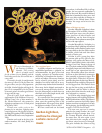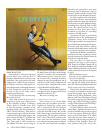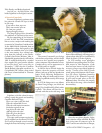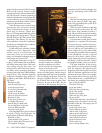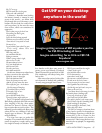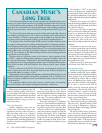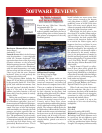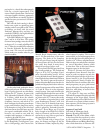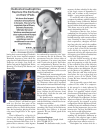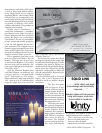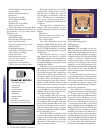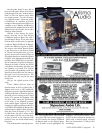
Feedback
Software
What about the Lightfoot style? He
has been called a crooner, and I leave it
to you to judge. What I hear is a superb
baritone voice, only moderately powerful
but always impressive, and sometimes
troubling. When he sings, he seems to
sing for you alone.
The artist honored
Gordon Lightfoot came onto the
record scene well before there were
regulations forcing radio stations to
play Canadian music (see Canadian
Music’s Long Trek above). It took them
years to finally get around to promoting
Canadian music, including Lightfoot’s. I
think I can venture to say that he helped
them out too.
The smattering of songs I have
quoted in this article give only a hint of
his inexhaustible fountain of inspiration
and his talent for turning inspiration
into song. That talent explains his rise
to the summits of artistic fame.
From 1965 through 1978, Lightfoot
receives 17 Juno Awards: best folk singer,
best singer, best composer, folk record-
ing of the year. He enters the Juno Hall
of Fame in 1986. He is nominated five
times for Grammy Awards: for Did She
Mention My Name?, If You Could Read
My Mind and The Wreck of the Edmund
Fitzgerald. He is made a member of the
Order of Canada in 1988, and a Com-
panion of the Order of Canada 15 years
later.
On October 2, 1997, at the opera
house in his home town, and before his
reconstituted family and his mother,
the principal auditorium of the opera
house is renamed the Gordon Lightfoot
Auditorium.
Lightfoot loves to tour. In 2001 he
sings at the House of Blues in Las Vegas,
as well as the MGM Grand, the Desert
Inn, and the Orleans.
All seems well when in September
2002, at a concert in Orillia, he is struck
down by an abdominal hemorrhage
and he is rushed to hospital. Follow-
ing surgery he is in a coma that lasts
several weeks. His loved ones, and
indeed all Canadians, follow his medical
bulletins.
Fortunately he survives and recov-
ers, and he spends little time thinking
about this brush with death. As soon as
he leaves hospital in October 2003, he
takes guitar in hand and begins vocal
exercises. With a new album, Harmony,
and an appearance on Canadian Idol, he
goes back on the road.
With his usual wry humor, he titles
it The Better Late Than Never Tour.
An unexpected gift
Before closing this glorious chapter
in Canadian artistic life, let me empha-
size that the Gordon Lightfoot of which
I have spoken is in no way diminished
or weakened by illness. He is a model
for us all. Realizing how lucky he has
been, he trains seriously and regularly.
He is, thus, a mature man, full of
health, perfectly recovered against all
expectations, who has lost none of his
charisma. Indeed — and I’ve saved this
for the last — after a US tour that took
him across the country he will, next Fall,
begin a cross-Canada tour.
He will start in Vancouver in Octo-
ber. From there he will go to Montreal’s
Place des Arts, Toronto’s Massey Hall
(his favorite!), Edmonton, Calgary,
Saskatoon, Regina, Winnipeg, Thunder
Bay and Ottawa.
He will, I predict, have a great time,
for he has never concealed the fact he
prefers to share his music in person with
his fans rather than being locked away in
a recording studio. “The pure pleasure
of playing live never wears off, even after
40 years in the business,” he says.
Canadian Music’s
Long Trek
If we sometimes deplore that the Canadian sound is too rarely heard on our own
airwaves, we might console ourselves by recalling that back in the 60’s there was
no real Canadian recording industry at all. English-Canadian songs were virtually
absent from the AM stations that were then dominant, and recording companies
did little to promote them. Artists who had recording ambitions had to go to the
US.
The Toronto Telegram actually ran an article with the title Canada Has a Booming
Record Industry (but only because it’s 95% American). Said the article under the pro-
vocative headline, “We have so many good records available to us from the States
that there’s really not much point in doing a great deal of recording up here.”
The knights of the Canadian labels finally reacted. Canadian musicians must
have a place on the artistic scene without exiling themselves. Courageous and deter-
mined, laughing off the insults, the hurdles, the disappointments, the setbacks, these
brave pioneers create the Canadian Talent Library. It was a non profit organization,
which would create recordings by Canadian composers and musicians. However
the CTL has no impact on the radio landscape. Station owners and programmers
heap ridicule on the enterprise.
However there is a worrisome rumor on the horizon. A new regulatory body,
the CRTC, might be thinking about imposing a quota of Canadian content on
the reluctant broadcasters. Frightened by this unthinkable possibility, the more
powerful station owners league together to inflate “cancon” and head off the menace.
They fill their airtime with Joni Mitchell, Anne Murray, and of course Gordon
Lightfoot.
The new chairman of the CRTC, Pierre Juneau, saw through the scheme. He
told the owners that, since there is so much cancon on the airwaves already, they
can’t possibly object to a quota…of 30%.
Subsequently, many Canadians thought they recalled that Mitchell, Murray and
Lightfoot had become popular because of the regulations. Not so. All three were
famous not only in Canada but in the US and elsewhere before “cancon” rules were
ever dreamed of.
The regulations did have their effect, however, and the choice of recordings
played on Canadian radio stations changed dramatically…and forever.
68 ULTRA HIGH FIDELITY Magazine






